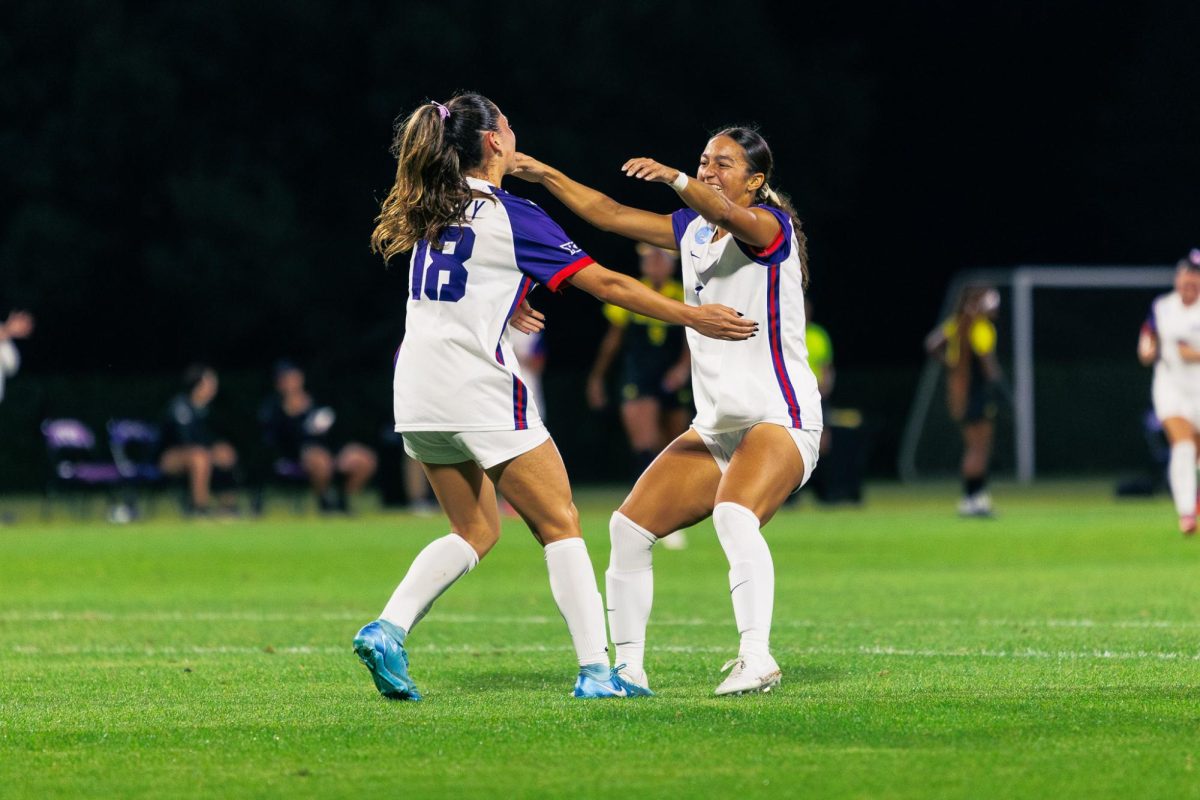Blue indicates members of the Big East Conference, purple indicates members of the Mountain West Conference and yellow indicates members of the Big 12 Conference. For additional information on location click specific dots on map.
Increased television exposure, more noteworthy opponents and a substantial cut in travel expenses can only equate to one thing for TCU football: a transition into the Big 12 Conference.
The move from the Mountain West Conference adds four teams that finished in last season’s AP Top 25 to TCU’s schedule, and all four are within driving range. The close proximity means more bus trips and fewer hotel stays, said Mark Cohen, assistant athletics director for media relations.
The farthest road trip next season will take the team five hours west to Texas Tech. Jack Hesselbrock, associate athletics director of internal relations, said the drive to Raiderland is slightly more than 300 miles but it's less of a hassle to drive.
Because of post 9/11 screenings, security and dealing with identification at airports, popping in a movie and enjoying the comfort and leisure of a drive is more convenient for both players and coaches, Hesselbrock said.
The closest opponent, Baylor, is a little more than an hour and a half away. The university is less than 90 miles away and a “straight shot down the interstate,” Hesselbrock said.
Cohen said that aside from a Nov. 3 meeting at West Virginia, the only other required flights will be to go to Kansas on Sept. 15 and to Oklahoma State on Oct. 27.
Airfare in the Big 12
The farthest Big 12 destination is West Virginia. The Mountaineers’ Milan Puskar Stadium is more than 1,200 miles from TCU but is still closer than TCU’s former Mountain West opponents San Diego State and Boise State. West Virginia is also closer than UConn and Rutgers, members of the Big East which had planned to welcome TCU to the conference this year before TCU’s change of plans in October.
Darla Reger, a travel consultant for Gulliver’s Travel in Fort Worth, has worked with TCU Athletics for 16 years and estimated travel costs to West Virginia to exceed $46,000.
An individual plane ticket is currently priced at $419. The $46,000 figure was an estimate on plane ticket prices for 110 players. The Athletics Department charters planes because of the number of seats they need, so the price may be even more than that figure, Reger said.
Reger said she estimated both Kansas and Oklahoma State flights each to cost the team between $24,000 and $27,000, estimating 110 plane tickets between $225 and $250 for each player. Again, Reger said additional charges come into play because of the need to charter planes.
By flying to three away games as opposed to six, the team would save a lot of money, she said.
On the road in the Big 12
Road games will dominate the travel culture of TCU Athletics going into the Big 12.
The team most likely will need three charter buses to fit comfortably, with each bus seating 55 people, Reger said.
For the shortest distance the team will travel next season — to Baylor — Reger said she estimated the cost to be between $1,500 and $1,600 per bus round trip. That included the cost of driving, lodging for the bus driver and gratuity, she said.
Reger estimated that the farthest driving location, Texas Tech, would cost the team anywhere from $2,000 to $2,100 per bus for a round trip.
Hesselbrock said he thought the convenience of road games would continue beyond next season.
“In a given year, the pattern of games are going to be Texas and Baylor on the road and Oklahoma at home along with Tech,” Hesselbrock said. “So you really have three potential road games every year that are going to be buses.”
Students and the Big 12
Students already have begun anticipating more affordable travel in the Big 12.
Junior sports broadcasting major Mike Buhtanic said he only traveled to TCU’s game against San Diego State last season and in previous years had not ventured farther than a road game at SMU during the regular season because of the distance of going to other road games.
Buhtanic and his friends considered making the drive to Boise State last season but did not because the trip would require 24 hours worth of driving one way, he said.
Lodging in the Big 12 also will be easier for students because they can stay with friends or family members in the areas, Buhtanic said.
He said he had a friend at every school TCU will play on the road and that he planned to stay with them instead of spending money to book a hotel.
Alumni and the Big 12
Steven Kellam, class of ’90 and whose parents are also alumni, said he attended TCU games since the 1970s.
Kellam said he traveled to several road games in the past and that the cost of his Boise State trip, which was between $2,500 and $3,000 for himself and his family of four last year, will not be missed when the price of traveling to away games falls to $300 to $400 in the fall.
“You can go to a number of away games and never have to get on an airplane,” Kellam said. “From a travel standpoint and from a costs standpoint, there’s nothing I will miss.”
Where the money goes
Money saved from spending less in travel is expected to stay within the athletics budget and help reduce overall expenses, Hesselbrock said.
“I don’t really see us taking that [money] and saying, ‘Oh, now we can do this or we can do that,’” he said.
A concrete figure of the football team’s travel budget is not available to the public.
Cohen said that as a private institution, TCU does not disclose financial information.
The graph represents the average, in miles, of each conference's distance from TCU.




